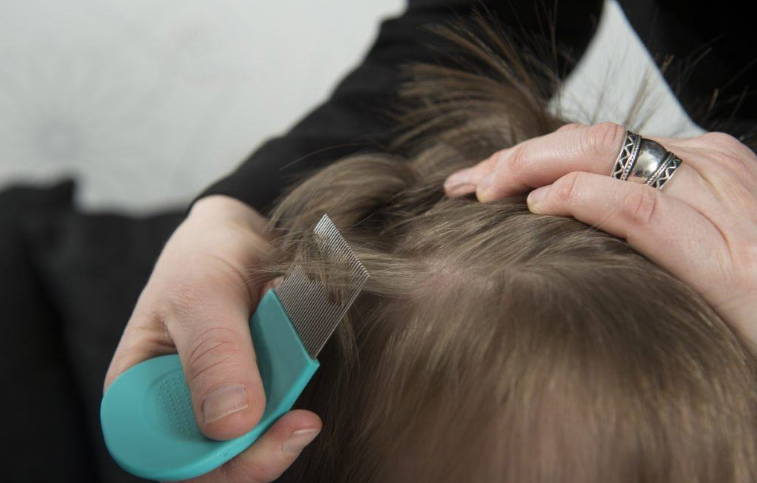How to get rid of head lice on a child's head
This is an automatically translated article.
Children's head lice are very common, especially in children 3 to 10 years old. Lice bites cause itchy scalp, increase the risk of skin infections and eczema, so treating lice in children is a concern for many parents.
1. How to detect head lice in children?
Head lice (also known as lice, scientific name is Pediculus humanus capitis) are very small animals that live on the head, about the size of a dragon fruit seed, with a brown or gray color. Head lice survive by clinging to the hair and biting the scalp to suck blood. Lice bites cause itching of the scalp, increasing the risk of bacterial superinfection and eczema.
Female lice reproduce very quickly. During her life cycle, a female lice can lay up to 150 eggs. If not removed, the eggs will hatch into baby lice in 7-10 days. Head lice in children may not be caused by poor hygiene in the child's parents, but by the child spreading it from classmates. The risk of lice is highest in children aged 3 to 10 years. Children often spread lice to each other when playing with or sharing items.
If parents feel that their children often have itching and discomfort in the scalp, the mother can follow the following steps to detect lice in children. Note, please choose a place with good light, use reading glasses or magnifying glasses to detect lice more easily.
Step 1: Detect signs of lice infection in children The chances of a child getting lice are very high if they have one or more of the following symptoms:
The child has a tickling sensation on the scalp, the sensation of something moving on the hair Children often scratch or rub their scalp, especially the area around the back of the head and ears. There are sores on the child's head from scratching. Children are irritable and irritable.

Trẻ thường xuyên gãi hoặc chà xát da đầu khi có chấy
Step 2: Conduct a search for head lice on the child's scalp (dry hair) The mother divides the hair into small sections to detect head lice on the child's head. Pay attention to check the hair behind the head and ears. It is difficult for mothers to detect lice because they are very small and move very quickly, but nits can be easily detected. Lice eggs are white or yellowish teardrop-shaped sacs that attach to the hair close to the scalp. Distinguish lice eggs from dandruff by the fact that nits adhere firmly to the hair while dandruff and other flakes easily fall off the hair shaft. Distinguish between live and hatched nits with the feature that live eggs will attach to the hair very close to the scalp (less than 1⁄4 inches away from oily skin) because they can only hatch when there is warmth next to the scalp , and the hatched egg will be in the hair away from the scalp.
Step 3: How to find lice in the wet hair stage If lice cannot be found in step 2, please wet the child's hair and use a specialized lice comb to find lice in children, these combs have the characteristics of comb teeth very close together.
First, the mother wets the child's hair, then combs the hair in sections from the roots to the ends. If there are lice in the child's hair, the lice will stick to the comb. You should shake the comb into the plastic bowl after each brushing to make it easier to detect lice.
If you determine that your child has head lice, check other family members. All family members must be treated to effectively treat childhood lice.
2. How is lice treated in children?
2.1. Use products to treat head lice There are many over-the-counter children's lice products on the market, which can come in the form of creams, shampoos, conditioners, etc. You need to read the description carefully. parts and instructions for use before using for children. Before applying the medicine, you should wrap an old towel around the child's shoulder, cover the face with the towel so that the medicine does not get into the eyes. You should wear rubber gloves when applying if there are open scratches on your hands. After applying, proceed to massage the product from the roots to the ends of the hair until the scalp and the entire hair are absorbed evenly. Pay special attention to the hairline at the nape of the neck and behind the ears. You may see lice fall out of your hair during the procedure. You can leave it on for about 10 minutes and then wash it off (it can be longer) or wash it immediately after applying depending on the specific instructions of each product.

Điều trị chấy ở trẻ em nên được tham vấn bởi chuyên gia y tế
Some cautions to keep in mind when using over-the-counter children's lice products:
Do not use children's lice products more often than directed Do not use more different lice at the same time. Do not use lice medication on eyelashes, eyebrows, or anywhere near the eyes. Do not use the product on skin with open cuts or scrapes. Do not use for children under 2 months of age.
2.2. Treating lice in children with a lice comb Using a lice comb to treat lice in children is a highly effective method if the mother needs to be careful and persistent. A lice comb can be used in conjunction with the use of lice products or used as a standalone treatment for head lice. This is the right method for mothers who are worried that the chemicals in lice products can affect their children.
The most important thing in this method is that you have to find a good lice comb. Should choose a specialized metal lice comb with long, smooth, closely spaced comb teeth. The time each lice comb depends on the length, thickness, straight or curly of the hair. To help your child stay still during the brushing process, you can let your child watch a video or read a book.
Before using a comb to treat children's lice, wet the child's hair, add a little conditioner or hair softener, and use a regular comb to comb tangled hair. When using conditioner, the process of combing the lice will be easier, because the lice move slowly on the comb. Divide children's hair into small sections, comb the comb from the scalp to the ends of the hair, mothers can see lice in children when pulling the comb through the hair. Scoop the teeth of the comb into the bowl, dip it in soapy water, or wipe the brush clean with a paper towel after each brushing. Brush each section in turn until the comb is clean (no lice or nits).
After you have combed the entire head of the child, rinse the conditioner off the child's head. Clean the lice comb, wash the clothes worn by the mother and child during the combing process. Brush your child's lice with a comb every day or every other day until you don't see live lice on the oily skin for about 2 weeks.

Trị chấy ở trẻ em bằng lược chải chấy
3. Treating lice in children with natural methods
Can treat lice in children with natural ingredients such as olive oil, tomatoes, vinegar, garlic, ... Some people also use mayonnaise, mineral oil. These ingredients are usually incubated on the hair for a period of time and then washed. However, because they have not been scientifically verified, the effectiveness of these methods is not guaranteed.
If using the above treatments does not help your child get rid of lice or have side effects, you should take your child to a medical facility for examination and advice from a qualified doctor.
Pediatrics department at Vinmec International General Hospital is the address for receiving and examining diseases that infants and young children are susceptible to: viral fever, bacterial fever, otitis media, pneumonia in children, .... With modern equipment, sterile space, minimizing the impact as well as the risk of disease spread. Along with that is the dedication from the doctors with professional experience with pediatric patients, making the examination no longer a concern of the parents. If you need consultation and examination at Vinmec Hospitals of the national health system, please book an appointment on the website for service.
Please dial HOTLINE for more information or register for an appointment HERE. Download MyVinmec app to make appointments faster and to manage your bookings easily.
Reference source: babycenter.com
This article is written for readers from Sài Gòn, Hà Nội, Hồ Chí Minh, Phú Quốc, Nha Trang, Hạ Long, Hải Phòng, Đà Nẵng.





